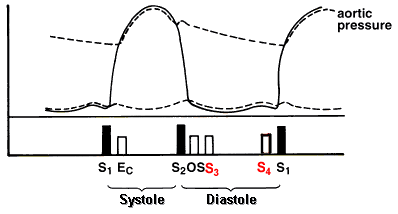| [Heart Sounds & Murmurs] | | | Liver & Ascites | | | Neck Veins | | | Pulmonary | | | Thyroid |
|
[Skill Modules
>>
Heart Sounds & Murmurs
>>
Techniques
]
Techniques: Heart Sounds & MurmursThird & Fourth Heart Sounds A triple rhythm in diastole is called a gallop and results from the presence of a S3, S4 or both. Description: Location:
If originating from RV
Third Heart Sound S3Description: Sounds like: Clinical Significance: Less commonly, valvular regurgitation and left to right shunts may also result in a S3 due to increased flow. May be normal physiological finding in patients less than age 40. Fourth Heart Sound S4Description: Sounds like:
In patient with mitral regurgitation, suggestive of acute onset of regurgitation due to the rupture of the chorda tendinae that anchor the Valvular leaflets. |
||||||||||||||||||||||||